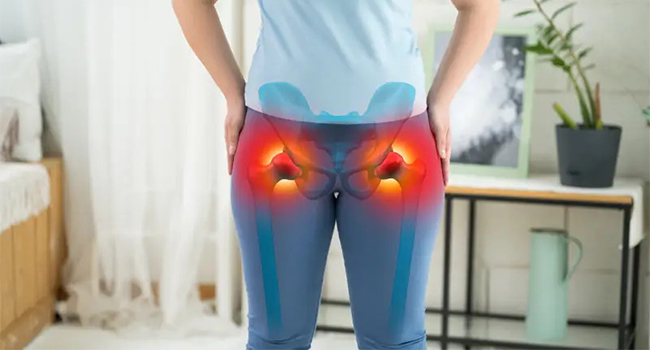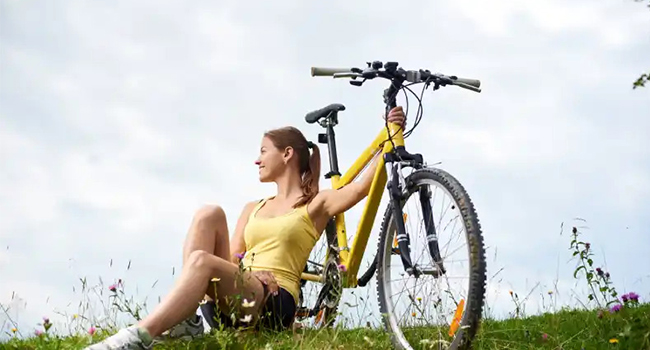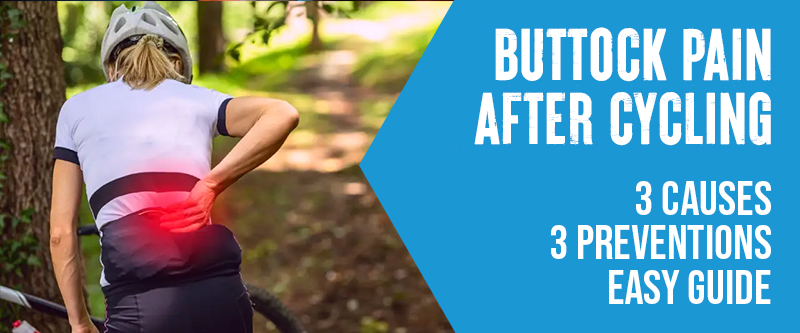Buttock pain may result from injuries, overuse conditions, or nerve compression, affecting sitting, standing, and walking. Identifying the underlying cause through medical evaluation for appropriate treatment and relief is crucial.
Buttock pain after cycling is often caused by improper bike fit, friction, rough roads with low-quality gear, and other factors.
To ease the discomfort, adjust your bike setup, upgrade your equipment, and do off-the-bike exercises to strengthen supporting muscles. Making and caring for these changes can reduce and prevent buttock pain from cycling.
This post will explore why this pain occurs, how to prevent it, and what you can do if your rear end is already rebelling.
Buttock Pain After Cycling: 7 Key Causes Explained

Cycling is a fantastic way to keep fit and enjoy the outdoors. Some cyclists experience a common issue of pain in the buttocks after riding. To tackle this problem effectively, it’s essential to understand its root causes. Let’s delve into each of them.
Disc Issues
Your spine’s discs act as shock absorbers, cushioning the impact of vigorous activities like cycling. Prolonged cycling can place excessive pressure on these discs, leading to discomfort in the buttocks.
Joint Problems
Your hip joints bear a significant amount of your body weight when you cycle. Overuse or improper cycling posture can result in joint strain or inflammation, causing pain in the buttocks.
Ligament Strains
Ligaments, the fibrous tissues connecting bones, can also get strained due to overstretching or sudden movements while cycling, causing buttock pain.
Back Pain after Cycling: Normalizing Discomfort
One of the most common complaints from new cyclists is a sore bum after riding. This is normal and usually temporary. Let’s dive deeper into understanding this phenomenon and how long it can last.
Discussion on the Initial Discomfort & Its Typical Duration
When you first start cycling, whether for fitness, commuting, or leisure, you might notice some discomfort in your buttocks region. This is due to the pressure exerted on this area while sitting on the bike seat for extended periods. Here are some key points to consider:
- The initial discomfort is a common experience among new cyclists.
- If you ride 2-3 days a week, the discomfort should subside after 2 weeks.
- If the pain persists beyond this period, there could be an issue with your bike’s fit or saddle position.
Remember, every individual’s experience will differ based on factors such as their physical condition, the type of bike they use, and how often they ride.
Normality of Butt Discomfort
Now that we’ve established that initial discomfort is normal, it’s essential to understand that experiencing some level of butt discomfort after cycling is part of the process. Here’s why:
- Cycling involves pressure and friction on your buttock region, which can lead to soreness post-ride.
- Over time, your body will adjust to the pressure exerted on the buttocks during cycling, and the discomfort will lessen.
- Specific products like anti-chafing chamois cream can help protect the skin from rubbing against the saddle and reduce discomfort.
✔ Top Pick: Anti-Chafing Chamois Cream
Many people use chamois cream to reduce friction and prevent soreness on longer rides.
Cycling Buttock Pain Prevention

While it’s normal to experience discomfort when you first start cycling, there are ways to make your ride more comfortable and prevent unnecessary pain. The crucial aspects we’ll focus on here.
Role of Proper Bike Fit in Preventing Pain
Having a bike that fits you correctly can significantly improve your comfort level while riding. Here’s why:
- A properly fitted bike ensures that your body is in the correct position when riding, reducing stress on your buttocks.
- If your saddle is too high or too low, it could lead to discomfort or even injury over time.
- Getting your bike professionally fitted can help you adjust your saddle height, handlebar position, and other factors to your unique body measurements. A well-fitted bike can help prevent buttock pain and other common cycling discomforts.
- Engage your core muscles during rides to help disperse weight between your shoulders and buttocks.
- Incorporate stretching exercises targeting the glutes and hips to alleviate post-ride soreness.
Additionals Tips For Stop Bum Hurting When Cycling
To alleviate discomfort in the bum while cycling, consider implementing the following tips:
- Set the Seat Height Correctly: Ensure your seat is adjusted to the right height to prevent unnecessary strain on your lower body.
- Change Your Position Occasionally on Long Rides: Shift your position periodically to relieve pressure points and distribute weight evenly.
- Practice Makes Perfect: Gradually build up your cycling endurance to allow your body to adapt and become more comfortable.
- Professionals Rely on the Right Preparation: To enhance comfort during rides, invest in quality cycling gear, such as padded shorts or a specialized saddle.
✔ Top Pick: Padded Cycling Shorts
Many people use padded cycling shorts to cushion pressure points and make rides more comfortable.
Saddle Rubbing Against Skin: Use Anti-Chafing Cream
Another helpful strategy for preventing butt pain after cycling involves using anti-chafing cream. Here’s how it helps:
- Anti-chafing cream, often called chamois cream, creates a protective barrier between your skin and the bike saddle, reducing friction.
- Regularly using this cream can prevent soreness and skin irritation caused by prolonged rubbing against the saddle.
- Applying the cream before every ride can significantly affect your post-ride comfort.
Use of Antibacterial Cream for Potential Saddle Sores
Cycling can cause saddle sores but can be managed effectively and appropriately. One way to do this is by using an antibacterial cream. Here’s why it helps:
- Regular application of an antibacterial cream can help speed up the healing process.
- The cream can prevent infection and reduce inflammation in the affected area.
- Applying the cream to any potential sore spots is recommended as soon as possible after your ride.
✔ Top Pick: Antibacterial Saddle Sore Cream
Many people use an antibacterial cream to help heal saddle sores and prevent infection.
Effectiveness of Icing for Temporary Pain Relief
Another practical method for managing post-cycling buttock pain is the use of ice. Here’s how it works:
- Applying an ice pack to your sore bum can help numb the area and relieve temporary pain.
- The cold temperature helps dull nerve endings and reduce inflammation.
- It’s advisable to use ice immediately after your ride for the best results.
A Sore Bum From Cycling: How To Treat It
Cycling can be a fantastic way to stay active and enjoy the outdoors, but sometimes it comes with the downside of a sore bum. If you’re experiencing discomfort in your buttocks after cycling, there are several steps you can take to ease the pain and promote healing.
Easing Off the Saddle
One of the primary causes of a sore bum from cycling is prolonged pressure on the buttocks. To alleviate this discomfort:
- Stand Up: Regularly stand off the saddle while cycling to relieve pressure on your buttocks.
- Adjust Your Position: Shift your weight occasionally from side to side or adjust your sitting position to reduce strain on specific areas.
A Chilly Reception for Soreness
After a long bike ride, giving your sore bum a chilly reception can help reduce inflammation and soothe the affected area:
- Cool Packs: Apply a cold pack or a bag of frozen vegetables wrapped in a cloth to the sore area.
- Cool Bath: A cool bath can also help lessen inflammation and provide relief.
Embrace the Healing
Allowing your body time to heal is crucial in addressing soreness from cycling. Here’s how you can facilitate the healing process:
- Take a Break: If your bum is sore, listen to your body and take a break from cycling until the pain subsides.
- Rest and Recover: Ensure you get adequate rest to allow your muscles and skin to recover from the strain.
Specialized Treatment
In addition to general care, there are specialized treatments that can target soreness related explicitly to cycling:
- Use Special Buttock Creams: Consider using creams designed to soothe and protect the skin on your buttocks. These creams can provide relief from chafing and friction.
Conclusion
To sum things up, buttock pain after cycling is a common issue, but it doesn’t have to be a deal-breaker. With a proper bike fit, anti-chafing and antibacterial creams, and a little patience, you can manage and even prevent this pesky problem.
Remember, initial discomfort is normal, but don’t delay seeking medical attention if pain persists. After all, cycling is all about enjoying the ride, and that’s hard to do when your backside is staging a protest.
So, prioritize your comfort and health because nothing should stand between you and the freedom of the open road.
What Causes My Bum Bone to Hurt After Cycling?
Tailbone problems frequently arise when a saddle is excessively soft, leading to excessive sinking of your coccyx and sit bones.
Alternatively, a saddle that is too narrow fails to adequately support your sit bones, while an incorrectly positioned saddle for your riding style can also contribute to discomfort.
Can Cycling Cause Buttock Pain?
If you are untrained, it is common for your muscles and bum to hurt after cycling. The body is not used to the sudden high strain, resulting in sore muscles in the buttock area. It’s better to take it slowly until your muscles have adapted.


